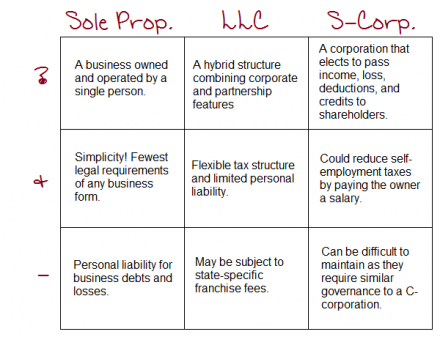The key reason most people look to “incorporate” their small business is to mitigate personal risk. The following business form will often protect your personal assets from liability.
What is it?
An LLC is a hybrid business structure that combines some of the features of a corporation (limited personal liability) and a partnership (“flow-through” taxation). One of their most popular features is that they provide the owners – or “members” – personal protection from business liabilities.
Note: An LLC is sometimes incorrectly called a “Limited Liability CORPORATION”. It is, legally, not a corporation. In many states, it is illegal to include the word “corporation” in the name of an LLC.
How do I do it?
LLCs are regulated by the state rather than the federal government, so it is imperative to review your specific state laws before formation. Your secretary of state should have information on his or her website. Formation generally involves filing certain paperwork designating the names of the members. This also usually involves a fee.
If you are starting an LLC with multiple members, be sure to have a membership agreement drawn up and signed by all parties to ensure management and executive decisions can proceed without issue.
Pros:
- Choice of tax structure. LLCs are the only enterprise formation that can be taxed as a sole proprietorship, a partnership, a C Corporation, or an S Corporation.
- Multiple member LLCs can choose to allocate specific items of income or loss to specific members, providing broader planning opportunities.
- Easier to maintain than a corporation (in terms of required annual disclosures and paperwork).
- Limited personal liability.
Cons:
- Depending on the state in which you form your LLC, you may be subject to specific LLC franchise taxes or fees.
- LLCs are not generally recognized abroad, so take this into consideration on initial set-up.
Tax Considerations:
- Generally, profits or losses flow through the business to the individual members and avoid the “double taxation” that corporations face.
- Profits or losses from single-member LLCs pass through to the individual owner and are reported on the Form 1040 Schedule C.
- The default rule for LLCs with multiple members is to treat them as partnerships for federal tax purposes.
- Income and loss must be reported annually on a Form 1065.
- The partnership reports distributions of income or loss to each partner on a Schedule K-1.
- The amounts from the Schedules K-1 are then reported on each individual partner’s income tax return.
- Any LLC, regardless of number of members, can elect to be taxed as a corporation by filing a Form 8832. After electing corporate tax status, an entity may select C or S corporation tax treatment.
- In some states, the LLC dissolves when all members have withdrawn, so plan for “termination” at the outset and pay close attention to your specific state laws.
- Owner of Single Member LLCs are well-advised to maintain separate bank accounts for personal and business use to avoid the appearance that the LLC was set up solely to avoid personal liability. There have been cases where LLC owners have been found personally liable if the LLC was seen as merely a screen.




